Shopping today is more of a virtual conversation than a simple sales transaction.
Conversational commerce offers a game-changing opportunity to do just that. This innovative approach leverages cutting-edge technologies to facilitate engaging conversations throughout the buying journey.
But how exactly does it work? And how can it provide your business with a competitive edge?
That’s what we’ll talk about.
Learn how to recreate in-store experiences in your online store
Let’s start with the basics—
What is conversational commerce?
Conversational commerce harnesses AI and machine learning to foster engaging dialogues, transforming the online shopping experience. By combining automated conversations with human capabilities, conversational commerce aims to create seamless and personalized interactions for customers navigating digital marketplaces.

Many top brands are using chatbots to enhance customer service and directly engage with their shoppers. In fact, real-time messaging is among the most effective ways of engaging customers, outperforming other traditional media like email. Research shows that over 72% of consumers use chat to communicate with the brand.
So—how does conversational commerce work?
Conversational commerce ensures the entire experience online to in-store remains as seamless as it can be.
Here are conversational commerce elements that make it possible:
- Proactive chat—offers real-time assistance and personalized recommendations
- Click-to-message ads—encourage users to initiate conversations via messaging apps
- Third-party messaging apps like WhatsApp—engage with retailers via text messaging
For example, a targeted ad on a Messenger conversation captures the attention of the shopper. This helps to educate the client on the brand’s product offering and entice them to visit the online retailers’ site. Once on the website, an AI chatbot takes over asking for specific preferences and leading the buyer through their shopping journey across every touchpoint.
What is the difference between conversational commerce and social commerce?
Social commerce refers to businesses or brands offering a complete shopping experience on their social media platforms. On the other hand, conversational commerce is the exchange of messages between a consumer and a brand on any platform before deciding to buy.
Now that we have distinguished the two—
What is the difference between conversational commerce and conversational marketing?
Although both approaches rely on conversations as their primary foundation, conversation commerce is based on real-time interaction taking place when selling goods and services. Meanwhile, conversational marketing is about developing brand awareness and client loyalty through personalized and genuine communication.
With definitions out of the way and the background information set, let’s have a look at the advantages of this strategy for brands.
What are the benefits of conversational commerce?
Attentive conversational commerce is very effective when interacting with consumers. Unlike email, interaction flows naturally without the need to wait days for a reply. With this approach, marketers can be more persistent in their engagement, as interaction history is preserved in the messaging app’s thread. With context now established, remarketing or re-engagement is credible and comes with context.
But why does it matter?
Well—here are the main benefits of conversational commerce:
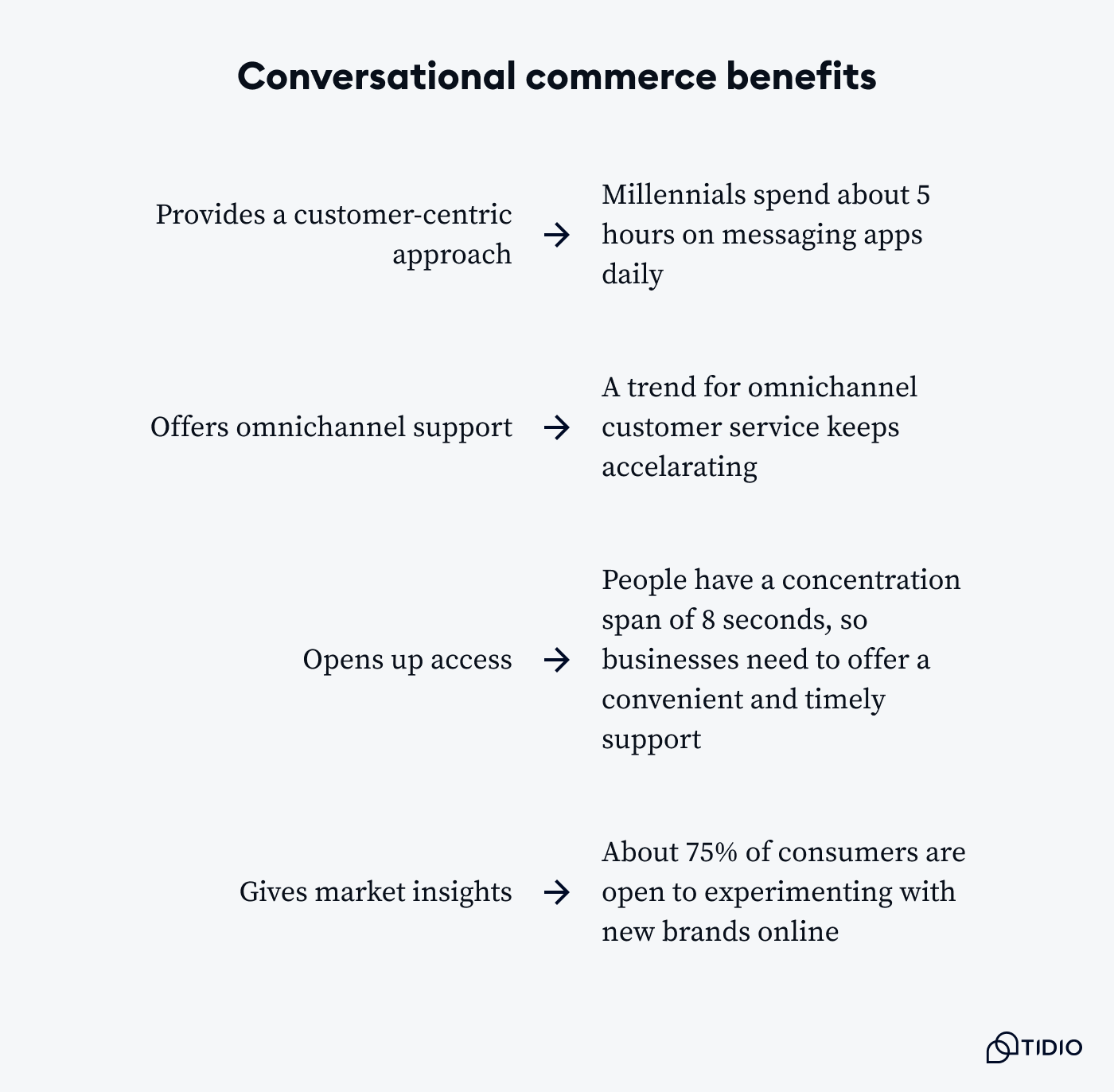
Provides a customer-centric approach
For starters, conversational selling significantly shortens the sales cycle and lowers the number of abandoned shopping carts. A real-time one-on-one feedback loop equally makes cross-selling and upselling much easier.
On top of that, brands and businesses are adapting to customer habits and preferences, particularly around text messaging. The global average time millennials spend on their phones daily is about 5 hours, a good amount of that time on messaging apps. Conversational commerce helps customers interact with a brand via messaging on widely adopted channels like WhatsApp.
Offers omnichannel support
Conversational commerce allows for your company to exist in any interface that the customer is interacting with. Despite operating across different interfaces, the goal is to maintain a standard context in all of them.
For example, a visitor can walk into a physical store, connect to the store’s website, and make an online purchase while getting in-store assistance. The whole process should be consistent and flawless.
An omnichannel experience does not mean being on every channel, but rather offering an all-encompassing customer experience. The trend for an omnichannel approach was accelerated by the global COVID-19 pandemic and hasn’t slowed down since.
Read more: Discover what omnichannel customer service is and get some tips to ensure your strategy is effective.
Opens up access
All the top-performing businesses already have some form of conversational commerce solutions in their marketing strategy. That’s partly linked to the fact that an average daily internet user spends around 88% of their time on apps.
Simplified messaging platforms like WhatsApp are powerful in terms of reach. The same applies to Facebook Messenger, Apple, and Google. It’s only a matter of time before customers shift entirely from simply shopping on retailer websites to going through the entire buyer’s journey using in-app chat and other communication channels.
Automates processes
Automating basic sales and support requests frees agents to handle more pressing customer support issues and other outbound calls. An automation approach further reduces the need to hire more team members, saving money in the long run.
With an average concentration span today of 8 seconds, conversational commerce appeals for its convenience and timely support. People are more receptive to messaging channels that deliver fast answers while going about their everyday routines.
Gives market insights
Brands get to learn more about their target market and identify shopping trends among their current customers through customer feedback. You can unravel areas of improvement by analyzing both chatbot and live agent conversations. Then, you should employ the knowledge to improve the conversational commerce experience on your channels.
According to a report, 75% of consumers are open to experimenting with new brands online, as businesses have shifted their focus to digital channels. With customer loyalty to brands becoming increasingly temporary, conversational commerce is seen as a favorable approach to staying competitive in this evolving landscape.
Read more: Discover more about customer service chatbots alongside their benefits and features.
Let’s examine some of the frequent challenges faced by brands when implementing a conversational commerce approach.
What are the challenges of conversational commerce?
The online shopping is here to stay and, most likely, grow. To adjust to the new realities, many companies employed conversational commerce solutions to mixed results. Here are some challenges and how businesses are iterating and solving them.
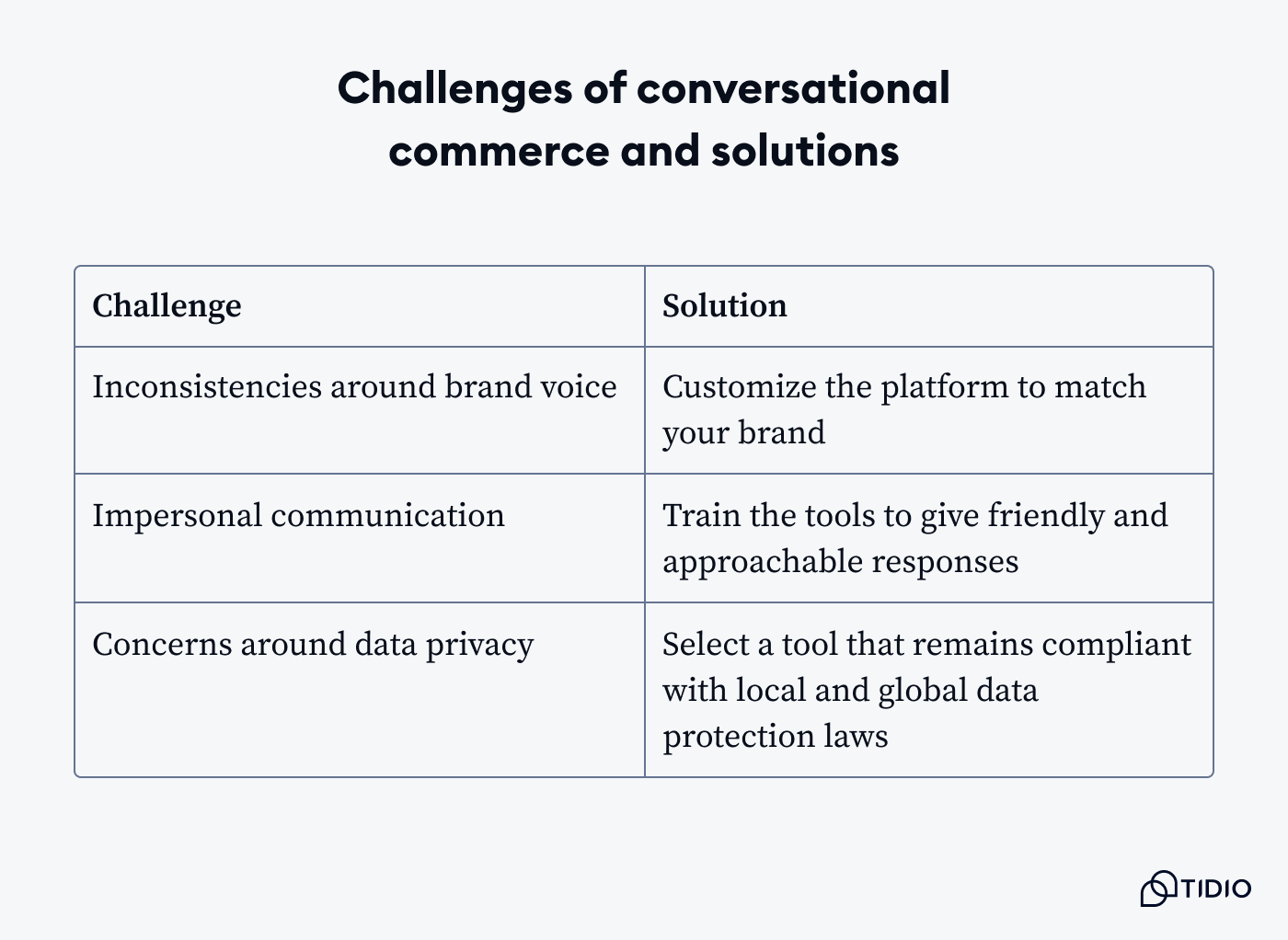
Inconsistencies around brand voice
An off-shelf conversational commerce might not provide the best results when adopted immediately as it mostly comprises of generic language and replies.
Solution to the challenge:
You should modify your platform to emulate your band’s voice and ensure the messages across channels are consistent. That way the system will properly respond to customers.
Impersonal communication
Conversational ecommerce chatbots can sometimes seem robotic, which doesn’t quite capture the cozy and personalized feeling you want your clients to get.
Solution to the challenge:
Train the chatbot to offer friendly, relatable, and approachable responses. This way your messages are interpreted to be arising naturally rather than as preset replies. When using live chat software, train the agents to make their customer conversations feel personal each time.
Concerns around data privacy
Businesses have the responsibility to keep customer data safe. Conversational commerce platforms capture, store, and process client information. It’s key to understand how this works and include it in your data privacy policy, otherwise, your business might get into a lot of trouble.
Solution to the challenge:
Select tools that remain compliant with local and global data protection laws, particularly those applying to GDPR and PSD2. Pay close attention to the relevant legislation to avoid any unintended breaches that could leave you liable.
Read more: Learn how Tidio handles security matters.
Let’s look into some real-life examples of how conversational commerce is impacting customer interactions for leading brands.
Examples of conversational commerce
Conversational commerce is all around us, and you’re probably interacting with it on a daily basis. From takeaway food deliveries to fashion brands, airlines and grocery stores, all businesses with an online presence are joining the trend.
Listed below are a few use cases with real-life examples:
Eye-oo
As an online eyewear retailer offering fashion and designer brands, eye-oo prioritizes exceptional customer service and quality craftsmanship. To enhance the customer experience while reducing response times, the company implemented an AI-powered solution. This allowed them to automate processes like shopping cart recovery while maintaining personalization. By leveraging the AI features, eye-oo achieved significant results, including a 25% increase in sales, a fivefold boost in conversions, and €177K in AI-attributed revenue.

Read more: Learn more about how eye-oo boosted sales and revenue after using Tidio.
H&M chatbot
Scrolling through endless products on an ecommerce site can be exhausting for some consumers. One way of going about this is by employing a conversational commerce chatbot that uses natural language processing and AI-powered technology to interact with customers.
For instance, in 2016 H&M launched a chatbot on the messenger app Kik where customers could see, share, and buy products online from the clothing store’s expansive catalog.

Anchor & Crew
Anchor & Crew is an online retailer of fashion waste selling bracelets, necklaces, and other jewelry. The company implemented a conversational sales platform that guides customers looking to make their first buy and understand the products they’re purchasing.

Domino’s Pizza
Domino’s customers can now order through their accounts by sending a message to the conversational commerce bots. This real-time interaction enables clients to personalize the order, and helps to build a closer relationship between the brand and the client. You can use the bot by simply clicking on the message button on Domino’s Facebook page or searching for Domino’s within the Messenger app making it convenient for the users.
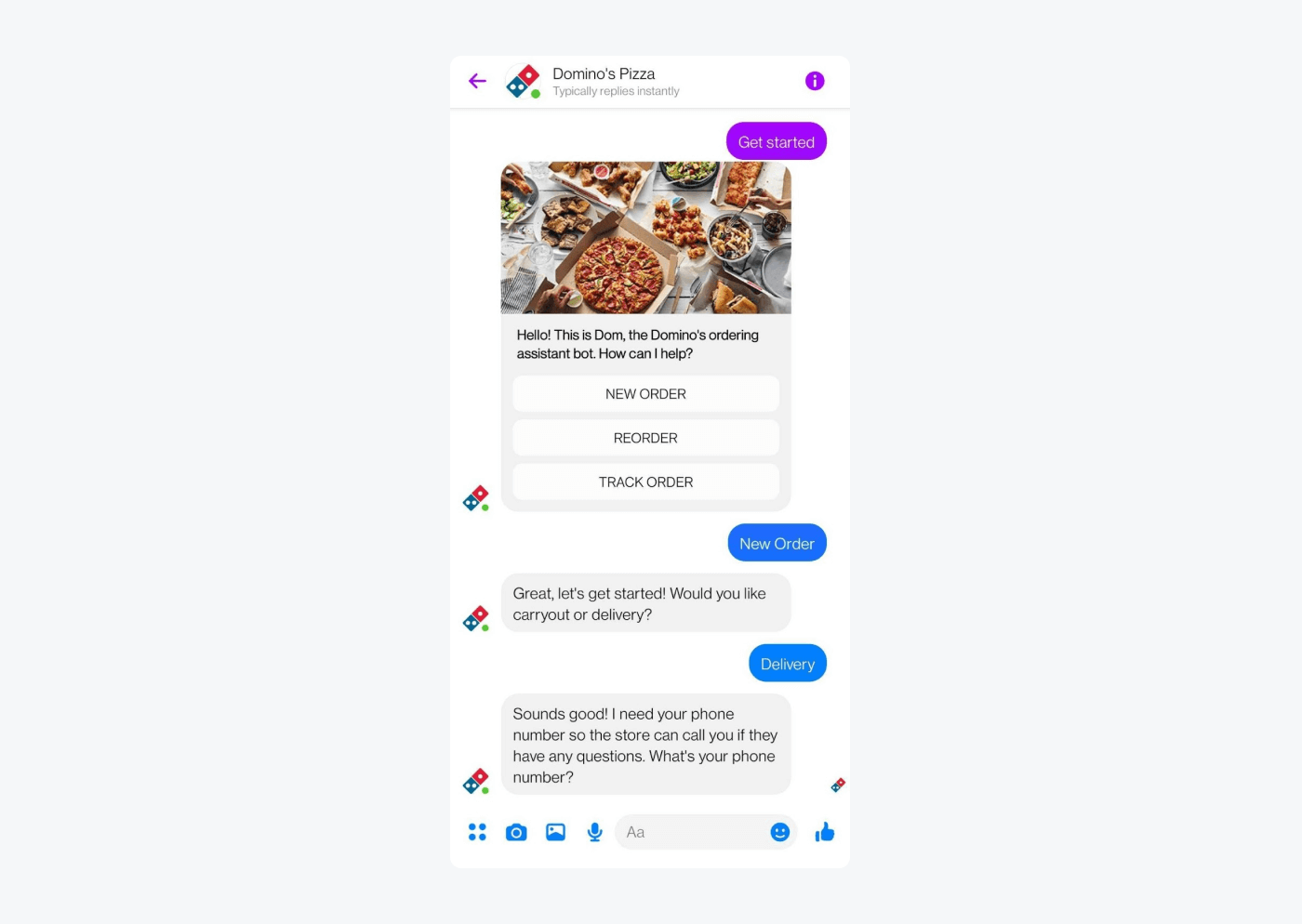
Alexa
Voice assistant search, such as Siri or Alexa, provides users with a natural way to locate their products and services online using voice commands. It introduces a conversational interface that minimizes unnecessary friction. For example, Amazon’s Alexa is a voice-enabled assistant that has completely changed how consumers search for products, buy and interact with the company.
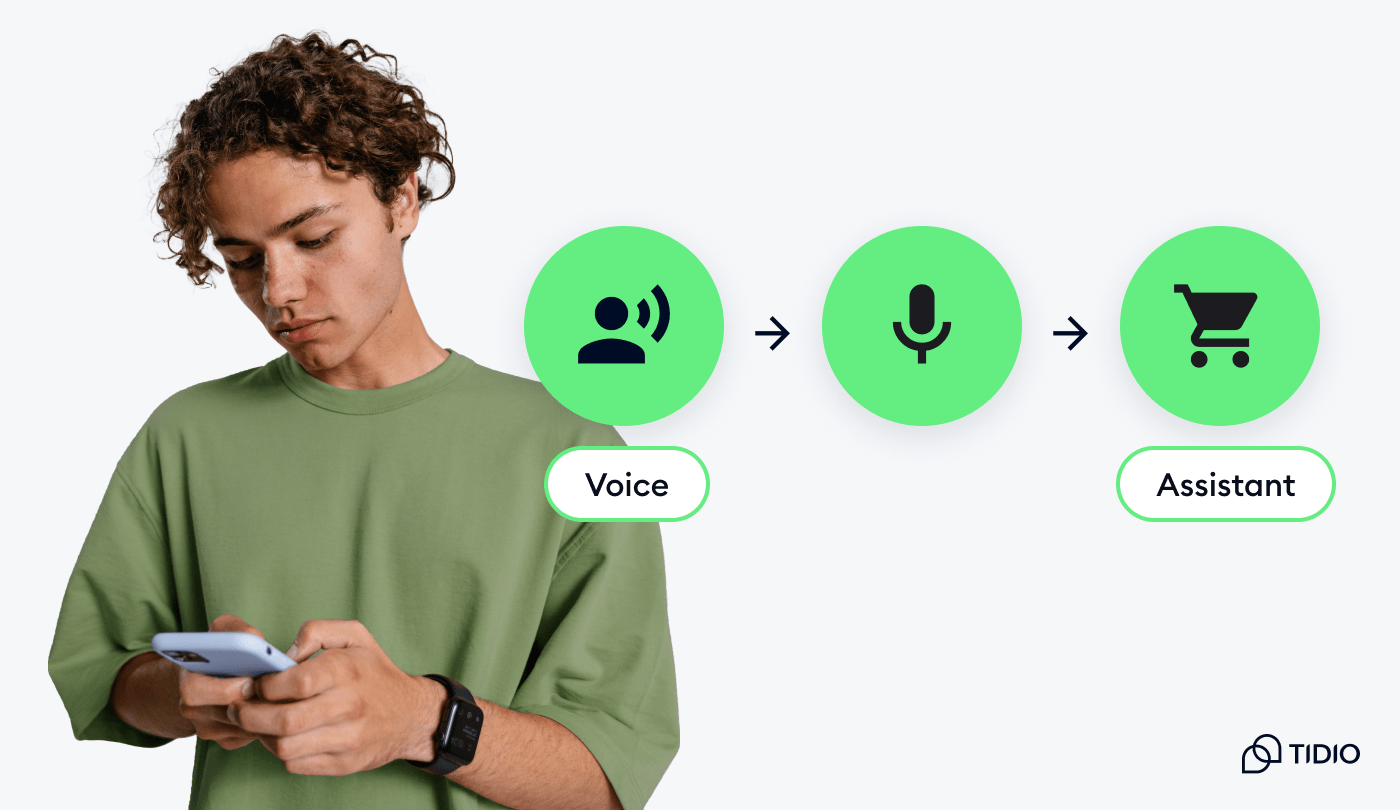
Wish
The affordable online marketplace platform Wish offers a conversational approach to its shoppers through WhatsApp. Potential buyers can ask a chatbot basic queries or FAQs for quick replies. The bot can also offer shopping suggestions with a couple of questions relating to the client’s preferences.

So, how do you implement these conversational commerce tools in your business? Let’s have a look at some best practices.
Best practices for implementing conversational commerce
To begin the transition, it’s important to determine the necessary changes and technology needed to effectively support users through your brand’s current communication channels.
Here are some tips and tricks on how to implement a conversational commerce strategy to your brand effectively:
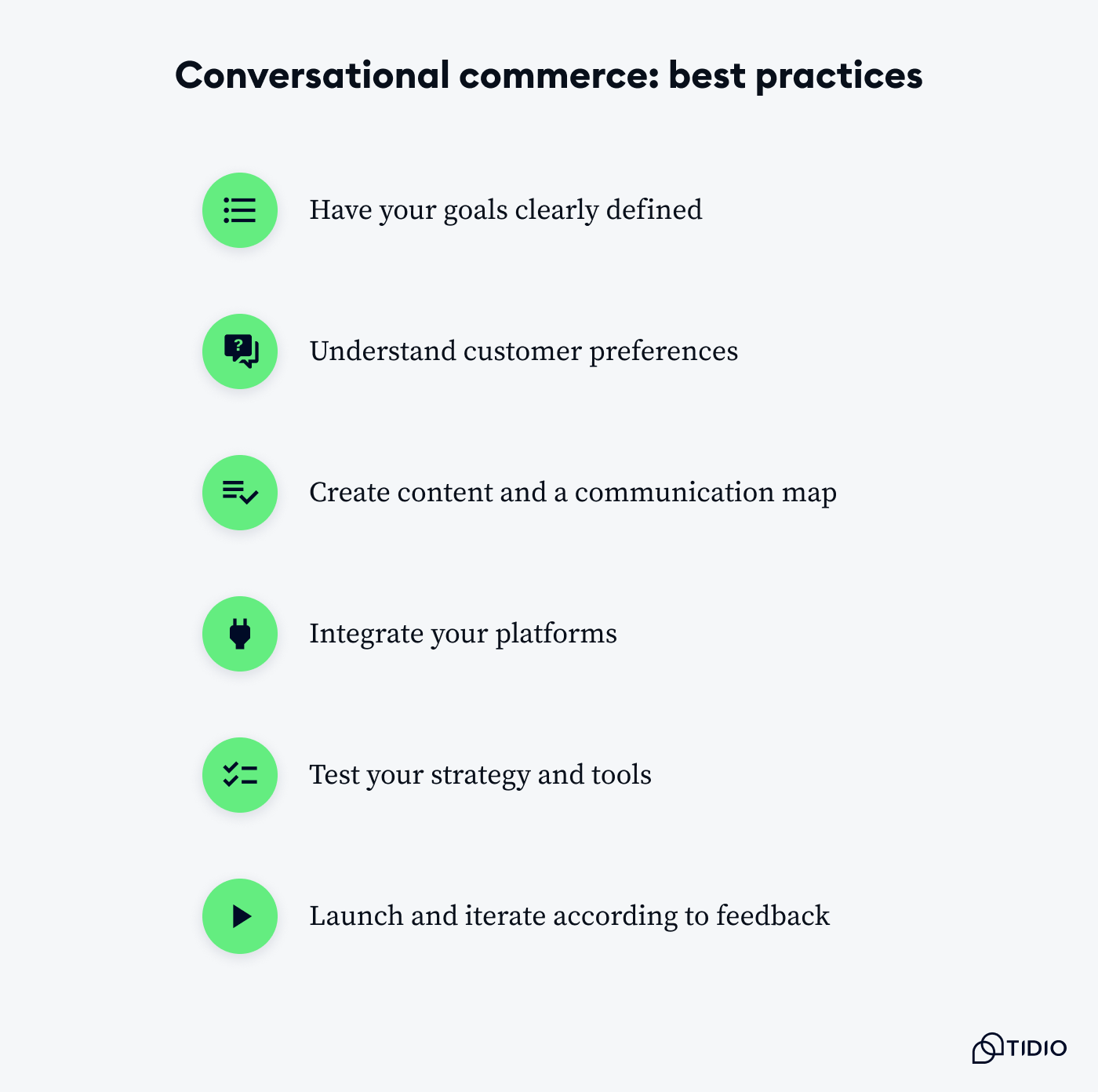
1. Have your goals clearly defined
As with every customer journey, begin by highlighting what issue you intend to solve with conversational commerce. While improving sales, customer satisfaction, retention, and conversion rates remain the key factors, go into more specific needs. Also, make sure that you set up goals that are SMART (specific, measurable, attainable, realistic, and timebound). This will provide a basis for maintaining accountability.
2. Understand customer preferences
Take some time to run mini-surveys and understand what makes up the customer’s needs. With today’s shoppers being so unpredictable, it’s likely that some preferences will come up in their feedback that you haven’t thought about. Also, look into setting up an omnichannel customer service and choose platforms based on the clients’ needs.
3. Create content and a communication map
Brands can use SMS marketing, live chat, social media apps, and chat apps to communicate with their customers. Live chat and in-app messaging can ask for feedback, recommend products, or direct users to resolve their inquiries via customer self-service. Social messaging apps, on the other hand, are best to establish deeper customer relationships.
4. Integrate your platforms
The next step is to merge the new strategy into your currently existing systems. A good example is when running a help desk system, you need to find out if SMS messaging API or WhatsApp chatbot suits your situation best. This way you can view all messages through a central inbox and route your inquiry to support agents where need be.
5. Train your teams and bots
Arrange training sessions for your staff on conversational commerce. Usually, this begins by explaining the need for a strategy and the objectives to achieve. The same can be said for technical and operational training. On top of that, you should also dedicate time to train the artificial intelligence tools to reply accurately to user input and improve your response time.
6. Test your strategy and tools
New strategies and technologies need to be vigorously tested before they are offered to customers. For example, give your chatbot feature and knowledge base a pre-trial run, as the generic data might not be in context with your messaging. In addition, when you’re testing your strategy and tools, it’s a good idea to think about adding performance tracking and live dashboards.
7. Launch and iterate according to feedback
When implemented all the steps mentioned above, you can now greenlight your strategy. Monitor how customers respond and monitor your customer engagement metrics such as customer lifetime value (CLV), client satisfaction, and net promoter score.
The future of conversational commerce
When in-store, a shopper can simply ask an assistant a question. Not having a similar form of guidance online can similarly make shopping isolating and frustrating. Conversational commerce fixes that by providing a dialogue between the user and an online store.
Research shows that sales from conversational commerce channels like chatbots, messaging, and digital voice assistants are predicted to experience significant growth from $41 billion in 2021 to $290 billion by 2025.
In places like China conversational commerce is heavily adopted given the widespread use of WeChat. The app lets users perform most of their daily tasks from hailing a cab to securing an appointment, paying utility bills, and messaging their loved ones. So, no wonder 25% of the 1.3 billion WeChat users spend over 4 hours on this app.
These trends are predicted to spread across the countries in the near future as conversational shopping becomes a standard practice for buyers. So, our future looks more conversational and automatic with putting customers’ conveniency as a priority.
Tidio is one of the platforms that help business owners integrate conversational commerce into their strategy.
Why not give it a test drive today?
Discover how to replicate in-store shopping experience in your store

